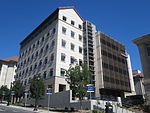Founders' Rock
Alameda County, California geography stubsNational Register of Historic Places in Berkeley, CaliforniaNatural features on the National Register of Historic PlacesSan Francisco Bay Area Registered Historic Place stubsUniversity of California, Berkeley

On the corner of Hearst Avenue and Gayley Road, in Berkeley, California, lies the Founders' Rock, the spot, according to college lore, where the 12 trustees of the College of California, the nascent University of California, Berkeley, stood on April 16, 1860, to dedicate the property they had just purchased. This is, supposedly, the same spot where Frederick Billings stood in 1866 when he remembered Bishop Berkeley's verse — "Westward the course of empire takes its way" — and thus inspired the name of the new city. A plaque was put on this spot on Charter Day in 1896.
Excerpt from the Wikipedia article Founders' Rock (License: CC BY-SA 3.0, Authors, Images).Founders' Rock
Fischerkoppel, Berkenthin
Geographical coordinates (GPS) Address Nearby Places Show on map
Geographical coordinates (GPS)
| Latitude | Longitude |
|---|---|
| N 37.8753333 ° | E -122.2568815 ° |
Address
Fischerkoppel
Fischerkoppel
23847 Berkenthin
Schleswig-Holstein, Deutschland
Open on Google Maps







